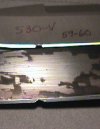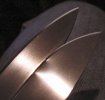To
shinyedges, Yes, it's like grains of wood ... except many MANY times smaller and also stronger, and again the PM process greatly reduces (but doesn't eliminate) the directionality of the grains.. is that even a word? Anyway, as
Ankerson and
Jerry have both noted, most edge damage isn't even caused by impacts, it is caused just as you describe, by cutting into hard materials or encountering slow-load lateral stress on the edge (google 'edge flex test'). When you split a piece of wood, for example, the grains of wood place lateral loads on the edge which can flex it out of alignment. If the edge is too soft, it will permanently deform (squash, roll/bend) which cold-works the edge to higher hardness and a thinner, more fragile geometry that can crack. If the edge is too thin and too brittle, it will resist bending but may fracture readily. If you cut into something hard, the edge will squash or try to bend around the object or may crack - same thing. This is all slow-loading, no impact-toughness value need be consulted.
Once a crack or other stress-riser (as Jerry described) is present, this focal point can lead to further crack-propogation... all in the absence of an impact. Now while some call this "toughness" it is important to qualify it as "fracture toughness" as a corollary of strength - i.e. the ability of a material to resist crack propagation, often discussed as "edge stability" in regard to knives) and not "impact toughness" (the ability of a material to resist crack formation, especially at a focal point, upon a sudden impact which can carry the crack to full failure).
As you've hit upon and
Ankerson has been trying to put forward, impact toughness is not the most important property of knife steel because it isn't the most common method of failure. Even chopping wood, the wood is usually soft enough that it slows the impact force to a compression force relating to strength rather than toughness.
But if you are unlucky enough (as I have been) to encounter an embedded spike or lock-staple or nail/screw/etc. on a strike, THAT is impact force and even my GSO-10 in CPM-3V suffered a major chip from than encounter! But I may have you note that the chip was much wider than it was deep. Can you tell me why?
In case not, it's because the longitudinal toughness was sufficiently high as a thickness a little back from the edge that the crack couldn't propagate any deeper but it
could propagate transverse along what little grain CPM-3V has to follow. Now if the transverse toughness had been higher, certainly the chip would have been smaller, but the chip would still be present because the threshold of longitudinal toughness was exceeded.
Anyway, you seem to have the right idea, I've learned somethings about S30V's origins that I didn't know before (and continue to be impressed about how responsive Crucible is to e-mails, this is the 3rd time I've read of quick replies from them to forumites :thumbup

, but the question I have is why oh why were both myself and
Ankerson posting to this thread so late into the night?

Sorry for another wall of text

Listen to
Jerry and
Ankerson - impact toughness is important, but not that important for knives. Use the values as a guide, but make sure you are comparing the same values for each steel (i.e. transverse or longitudinal but don't mix-and-match). In the end, the best test is how the knife blade actually performs in use, not what value a generic test-specimen gives. SOOO many other variables for knife edges. :thumbup::thumbup:



